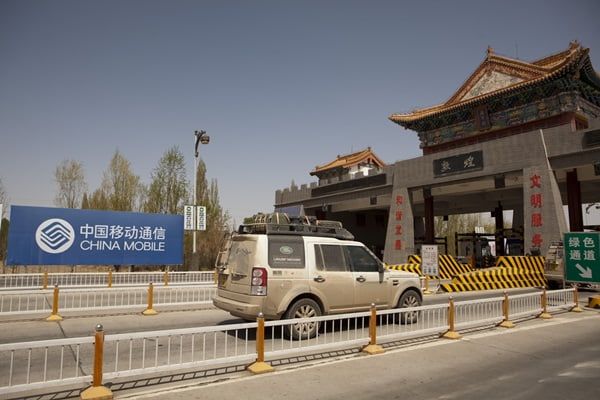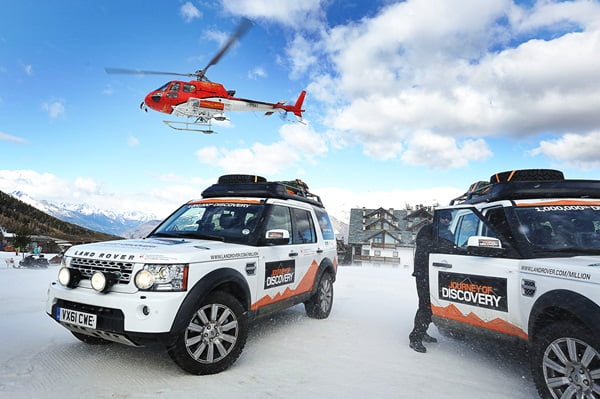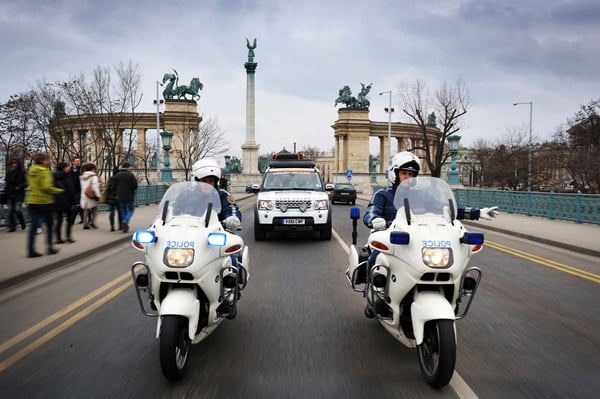
The epic Land Rover Journey of Discovery is now just a few thousand miles from the bright lights of Beijing – but it had to overcome a minefield of obstacles to finally reach the border into China, its final country on the 8,000-mile fundraising trip.
Leaving the urban jungle of Tashkent behind, the team took on a challenging route through three different countries, via the remote lake of Issyk-Kul, and as communications faltered and roads worsened, the journey became an adventure once again.
After five hours of checks across the Uzbekistan/Kazakhstan border, the relentless potholes on the Kazakh roads forced traffic to zigzag haphazardly in avoidance. Punctures were inevitable, but the team coped admirably as they pressed on into Kyrgyzstan.
Markedly improved roads made driving as comfortable as it was spectacular, with pancake-flat fields on one side of the road and the snow-covered North Tien-Shan Mountains rising 4,855m on the other – but those mountains had to be crossed at some point.
When that point came, the Land Rover Discoverys’ breadth of capability was the perfect match, with everything from Terrain Response to lower range gears needed to make it through the dramatic Ala-Archa National Park, a steep-sided snow-filled gorge that just 23 years ago was off limits to all but the soviet elite.
Through Bishkek, the road continued to the Lake Issyk Kul Biosphere Reserve, where the vast Aurora sanatorium, which once hosted Moscow elite including Presidents Brezhnev, Gorbachov and Yeltsin, now takes pride of place in a new economy serving Chinese tourists and wealthy Kazaks.
Lining the road around this unique and luxurious spa are the more traditional yurt tents, home to some 20 percent of the 5 million Kazak population. Now a more common form of cool camping holidays and festivals in the West, the circular felt super-tents play a more essential role in Kyrgyzstan life.
This nomadic ‘grand design’ can be carried in one small trailer and is knocked up in less than two hours.
Bizarrely the front door goes up first, the anchor for stretches of collapsible willow trellising that expands into ‘walls’ of the basic circular frame, with the roof’s round wood wheel centre held aloft on a wooden pole with strips of willow bent at an angle over hot steam connecting it all up.
Inside, it’s a full-on psychedelic assault on the senses, with multi-coloured rugs, quilts and hangings. At one hour and forty-five minutes, with the final felt slipped over the central roof hole, the yurt was complete and the team was able to experience the true hospitality of the people of the region.
In nearby Kochkor, the Kochkor-Kutu Co-operative employs 60 staff from the villages to produce up to 100 gorgeously patterned rugs each year.
Thirty-one year old Fatima is her family’s fourth generation in the thousand-year-old industry. She explained how the sheep’s’ wool is beaten with sticks, soaked in water, rolled into handmade bulrush mats and flattened by foot. “We dance on it with our feet,” she said. “And finish it with our hands.”
Back on the road, the most spectacular scenery was yet to come as the team closed in on the Chinese border, with an undulating lunar landscape, lapped by turquoise waters of tropical intensity beside multi-coloured mountains split by ravines and populated solely by a herd of camels.
But with the 3,752m Torugart Pass in its sights, news came of a potential disaster.
The Journey of Discovery had been in Moscow when it learned the route through the Tian Shan mountains, a challenging pass some 2.5 miles above sea level, was closed by a massive avalanche.
That lasted for a week, but by the time the Journey reached Kazakhstan it had been cleared and the problems appeared to have been averted. That was until 72 hours before the scheduled crossing, when another avalanche blocked its path.
It flashed back to memories of the first overland expedition in 1955, which followed a similar route but had to change destination at the last minute.
But this time the route was cleared quickly and, on rough and rutted roads flushed with snowmelt and rubble, the Discoverys got their chance to head to the border.
Fuelled up from Kyrgyzstan with enough reserves for the drive to the border and back if required, the team carried two days of food and water and took satellite phones for security. So thick was the dust that each car drove over a mile apart.
As lesser vehicles lay in pieces by the roadside, the technological advancements of the Land Rover Discoverys came into their own and, finally, 13 countries since Birmingham, the last crossing was complete. Now, there is just the challenge of crossing the entire length of China in time for Beijing…
Follow us on our journey and please help us reach our target.
Find out more at www.landrover.com/million
http://www.facebook.com/landrover





